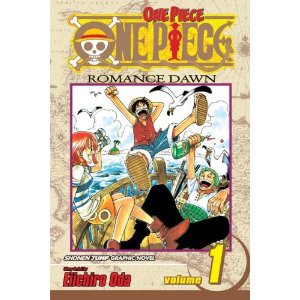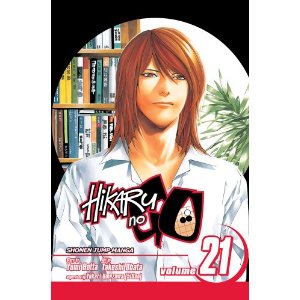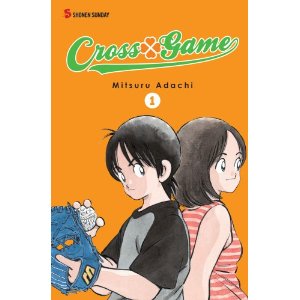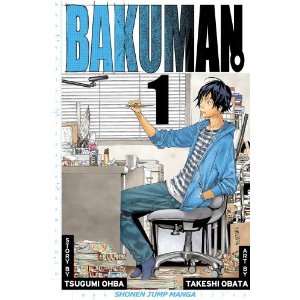One thing that I’ve found a little off-putting about One Piece is the wide consensus that it takes quite a few volumes to really get going. I tend to follow a two book rule on principle when evaluating manga series to see if I want to collect them, because while I’ve read plenty of so-so first volumes that develop into an interesting series by volume two, I have a limited amount of patience when it comes to the idea of collecting several volumes just to get to the good stuff. But I only have the first two volumes on hand right now, so that’s what I’m going to look at today. I’m going to attempt to show what might lead a reader to assume that the series isn’t so great and also highlight the aspects that might cause someone to come back for more.
The first chapter of One Piece follows a very typical shonen formula. An adventurous proto-hero gets inspired by a total bad-ass and decides to become a hero himself. I’m sure there are numerous examples of other manga that have similar beginning chapters, but the ones that come to my mind immediately are Tegami Bachi and Gun Blaze West. The heroic quest idea gets a little bit of a twist in One Piece because Monkey D. Luffy decides that he’ll become “The King of the Pirates.” Luffy is aided in his ambition by his inadvertent ingestion of the fruit of the Gum-Gum tree, which adds him to the ranks of stretchy superheroes. I’ve often thought that elastic powers give a cartoonist the license to go absolutely crazy, but Luffy’s powers mostly seem to manifest in near-invulnerability and the ability to do devastating super-stretchy punches.
Luffy is a hero who is made engaging due to his almost stupid levels of enthusiasm and his tendency to leap into action without any fear for himself. He sets out in a dinghy for the fabled “One Piece,” the legendary pirate treasure that will make him Pirate King. Luffy’s early adventures show him gradually assembling a team that will help him fulfill his quest. He’s joined by Zoro, a swordsman with a hilarious three-sword technique (he fights with swords in both hands and one clenched in his teeth) and Nami, a greedy femme fatale of a navigator.
The art in One Piece is one aspect that might be off-putting to a new reader. Oda’s style is cartoony, with plenty of exaggerated facial expressions. If someone comes to One Piece wanting slick art featuring the giant blades and billowing costumes of Bleach, they’re going to be disappointed. I enjoyed the Oda’s art, just because it looks very different from most shonen titles. I especially appreciated the variety in the character designs for the villains Luffy faced, which ranged from a hideously gigantic pirate queen to a corrupt navy captain with an iron jaw and an axe for a hand. I wasn’t surprised to see that Oda once worked as an assistant on Rurouni Kenshin, because I always thought one of the great things about that series was distinctive villain character design. That’s something I look for when reading shonen manga, so that goes in One Piece’s bonus column for me.
The storyline in the first couple volumes will likely perplex anyone who is wondering why One Piece is a bestseller in Japan. Luffy pulls his team together due to his enthusiasm and genuine friendliness. Even if other characters initially think Luffy is crazy, they end up falling in with his plans despite their earlier intentions. The first couple volumes feature plenty of fights made more interesting by the unique qualities of the villains as well as some episodes that have a bit of after school special type moralizing about the power of friendship. Luffy meets a boy whose ambition is to join the navy and fight pirates, and he becomes Luffy’s first friend from outside his village. Later, a dog’s loyalty is shown to endure past the life of his master in a town decimated by pirates.
The emotional tone in the first couple volumes is one thing that I think hasn’t gelled yet. The series seems on the surface to just be fairly goofy, with the exaggerated villains, plenty of action scenes and jokes, and a hero who can’t be hurt by anything. But there are scattered scenes that emphasize the arbitrary nature of violence and death. Luffy’s hero gets his arm bitten off by a shark and seems largely unconcerned about the sudden amputation. Zoro’s back story is about moving on from tragedy and while Luffy is largely unharmed by fighting with pirates, his companions don’t have that luxury. Zoro fights past the point of exhaustion and announces his intention to sleep on the battlefield, and Luffy cheerfully flexes his muscles and decides to take over. The darker element of violence mixed with the more frivolous elements and usual shonen boosterism of friendship might hint at darker times ahead for Luffy and his crew, and that’s what I’d be interested in seeing later on in the series.
If I was just going by the first couple volumes of the series, I might just assume that One Piece was just a slightly better than average shonen series, with the added bonus of piracy. But seeing how many people are genuinely enthusiastic about this manga makes me think I should at least check out a few of the omnibus volumes even though I am frightened of getting hooked by a 60+ shonen series. I will be looking for One Piece at my local library too.



